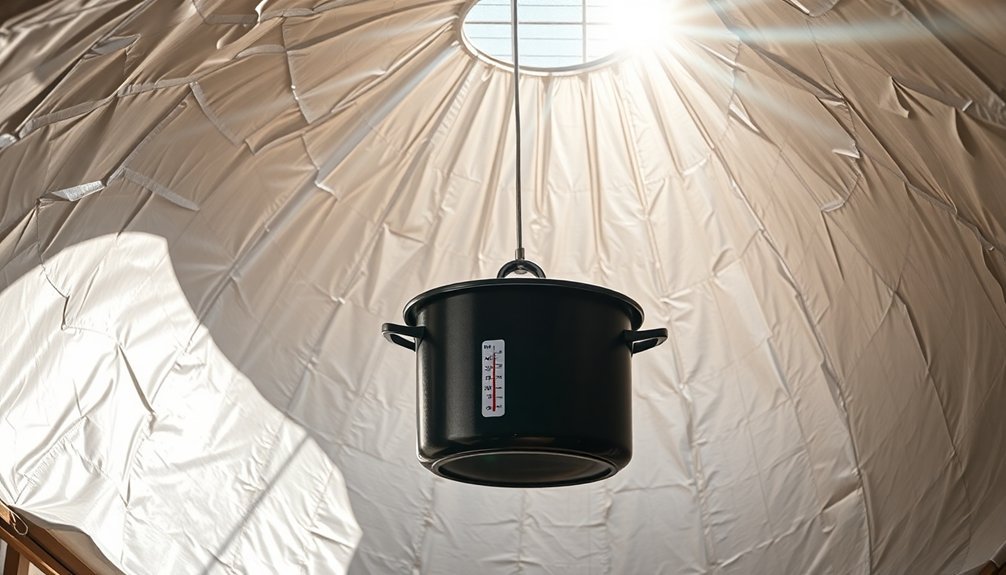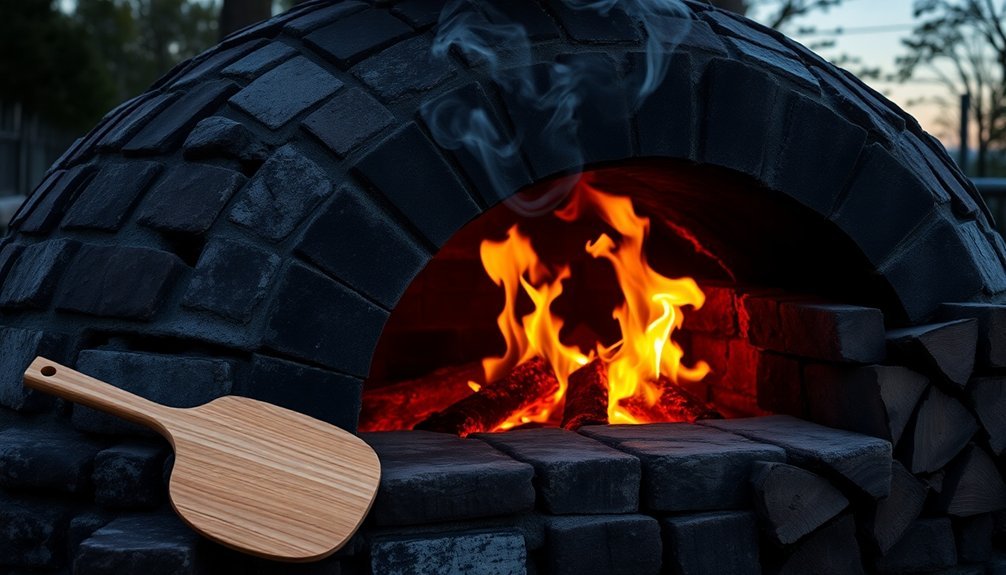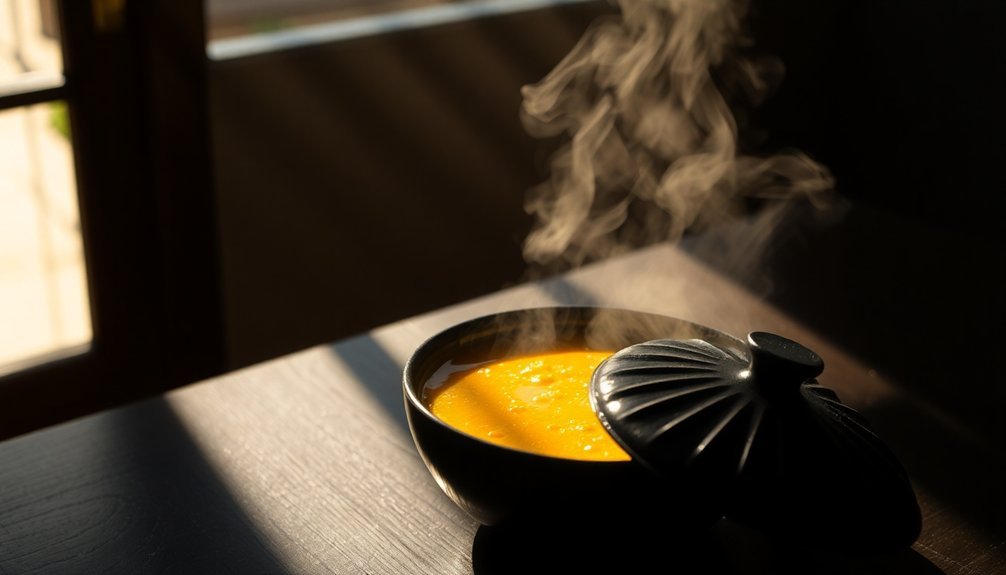Your success with seasonal solar cooking starts with your region's specific sunlight patterns. In the Northeast, focus on 11 am to 3 pm cooking windows during spring, while Southern states can utilize longer sun hours year-round. The Midwest requires attention to 10 am to 4 pm slots on clear days, and coastal regions can extend cooking from 8 am to 6 pm in summer. You'll need the right equipment – dark cooking vessels in the Midwest, parabolic cookers for tropical zones, and insulated chambers for arctic areas. Each region's unique conditions shape your ideal approach to solar food preparation. The journey to mastering your regional solar kitchen awaits.
Regional Solar Kitchen Equipment Essentials

While solar cooking equipment varies by climate, understanding your region's specific needs will help you choose the most effective tools.
In tropical areas, you'll want parabolic cookers for high-temperature cooking and vacuum tubes for heat retention. Desert dwellers should focus on concentrated solar power and insulated box cookers with wind protection. These efficient devices can reach temperatures of 550°F, making them perfect for diverse cooking needs.
For temperate zones, you'll benefit from versatile options like the GoSun Portable Solar Cooker, which handles everything from eggs to brownies.
Don't forget adjustable panel cookers to maximize varying sunlight conditions. If you're in arctic regions, prioritize heavily insulated cooking chambers and supplementary power options.
You'll need to double your cooking times and use reflective surfaces to maximize limited sunlight. Choose heavier cookware to maintain steady temperatures when clouds interfere.
Northeast Solar Cooking Patterns
You'll find the most effective solar cooking times in the Northeast between 11:00 am and 3:00 pm, when spring harvests of leafy greens and early vegetables can be perfectly prepared.
During spring's moderate sunlight conditions, you'll need to double your conventional cooking times and keep a close eye on your thermometer to guarantee food safety. Using dark cooking pots will help maximize heat absorption and cooking efficiency in the cooker.
Your spring dishes, from steamed asparagus to baked rhubarb desserts, will turn out best when you schedule your cooking sessions around these peak sunlight hours.
Northeast Spring Harvest Uses
As spring emerges in the Northeast, abundant local produce transforms home cooking possibilities, especially for solar cooking enthusiasts.
You'll find tender asparagus from May through June, perfect for solar roasting with olive oil and herbs. Early greens like arugula, spinach, and pea shoots arrive in April and May, ideal for fresh salads and quick solar-wilted side dishes. Using a parabolic dish concentrator ensures optimal cooking temperatures for these delicate spring vegetables.
Don't overlook unique spring delicacies like fiddleheads and ramps in April and May, which you can incorporate into solar-steamed vegetable medleys.
Garlic scapes and fava beans peak in May and June, working beautifully in solar-slow-cooked stews and casseroles.
For longer-term enjoyment, try solar-pickling radishes or creating preserves with early rhubarb. You can even solar-dry spring herbs and greens to capture their peak flavors.
Peak Solar Cooking Times
Understanding when to solar cook in the Northeast requires careful attention to daily and seasonal patterns.
You'll find your most effective cooking window between 10:00 am and 2:00 pm, when the sun reaches its highest position. To check if conditions are right, look at your shadow – if it's shorter than your height, you're good to go.
In this region's challenging climate, you'll need to adapt your cooking schedule. Pre-heat your solar oven early and plan for longer cooking times, especially during fall and winter months.
When you're dealing with the Northeast's frequent cloud cover and fog, it's smart to split cooking sessions across multiple days. Consider altitude benefits, even though you're far from the equator, and maintain oven warmth during less sunny periods.
Southern States Sunshine Schedule

The abundant sunshine across Southern states greatly influences local growing seasons and food preparation methods.
You'll find exceptional growing conditions with Florida, Georgia, and South Carolina each receiving over 2,800 hours of annual sunshine and maintaining sunshine percentages around 65%.
You can expect more than 100 clear days per year in these states, making them ideal for various growing seasons.
You'll find summer crops like okra and tomatoes thriving from May through October, while winter vegetables such as cabbage and kale flourish in the mild Southern winters.
Year-round sunshine supports continuous cultivation of staples like collard greens and sweet potatoes.
When planning your gardening or cooking schedule, you'll want to note that specific cities like Tampa, Macon, and Columbia often serve as reliable indicators of regional sunshine patterns.
Midwest Solar Food Preparation
Moving from the sunny South to the heartland, Midwest solar food preparation requires strategic timing and specialized equipment to maximize available sunlight.
You'll need to focus your cooking between 10 am and 4 pm on clear days, while keeping alternative fuel sources like fire pellets handy for cloudy periods.
To get the best results in the variable Midwest climate, use dark cooking vessels like cast iron or granite ware.
If you're using glass dishes, paint them black or wrap them in dark towels.
You can maintain temperatures between 180°F and 350°F by using reflectors and proper lid coverage.
Try cooking regional favorites like zucchini lasagna or barbecued ribs, which work well in 2-4 hour cooking cycles.
You'll find that solar cooking not only saves energy but also preserves nutrients through slow, even heating.
Coastal Region Cooking Times

Successful coastal region cooking depends heavily on maximizing peak sunlight hours throughout the changing seasons.
You'll find the ideal window for solar cooking between 11:00 a.m. and 3:00 p.m., though summer extends these hours from 8 a.m. to 6 p.m. Winter cooking narrows your timeframe to 10 a.m. through 2 p.m.
For best results with coastal ingredients like fresh shrimp, scallops, and local produce, you'll need clear skies and distinct shadows on the ground.
Position your solar cooker on level ground in direct sunlight, away from any shade. Remember to double your conventional cooking times when using solar methods.
You can prepare favorites like grilled shrimp tacos and coconut lime rice, but you'll need to adjust timing based on sunlight intensity and seasonal variations.
Mountain Area Solar Methods
While mountain regions present unique challenges for solar cooking due to varying altitudes and weather patterns, you'll find that proper equipment design and setup are essential for success. You'll need to adjust your solar oven's angle more frequently at higher elevations, typically maintaining 60-degree inclination during winter months.
| Mountain Setup | Best Practices |
|---|---|
| Insulation | Use extra fiberglass or feathers |
| Positioning | Face south, clear of shadows |
| Thermal Mass | Add two bricks for altitude |
| Reflectors | Double-layer aluminum foil |
| Weather Check | Monitor cloud patterns |
To maximize heat retention at altitude, you'll want to double your insulation materials and use two thermal mass elements instead of one. Don't forget to preheat your oven longer than usual – about 45 minutes – since mountain air is thinner and temperatures can fluctuate rapidly.
Desert Climate Cooking Strategies

When cooking in desert climates, you'll need to adapt your methods to handle intense heat while preserving precious moisture in your foods.
You can protect dishes from drying out by using traditional techniques like pit cooking, where food cooks slowly underground, or by employing covered clay pots that naturally regulate temperature and humidity.
To maintain moisture in your dishes, you'll want to use water-saving methods such as steaming and braising, while also keeping cooking vessels tightly covered to trap essential moisture during the preparation process.
Desert Heat Cooking Methods
Living in desert climates requires adaptable cooking methods that work with intense heat and limited resources. You'll find that traditional underground cooking offers an efficient way to prepare meals while avoiding the scorching daytime temperatures. By digging a pit and lining it with hot rocks, you can slow-cook meat and vegetables to tender perfection.
For mobility, you'll want to rely on portable stoves and metal pots, which are vital for nomadic lifestyles. You can fuel these stoves with wood or dried camel dung.
The dome-shaped taboon ovens are perfect for baking khubz flatbread on hot stones, while clay pots help retain precious moisture during slow-cooking. When using local ingredients, you'll notice that generous spicing is essential, as desert conditions can diminish natural flavors.
Moisture Retention Techniques
In desert climates, preserving moisture during cooking becomes essential for creating tender, flavorful dishes.
You'll find that slow-cooking methods, particularly in clay pots or underground ovens, help distribute heat evenly while keeping ingredients moist and tender.
To maximize moisture retention in your desert cooking, consider these proven techniques:
- Use moist-heat cooking methods like braising and stewing at temperatures below 180°F, skimming any scum that forms.
- Try pit cooking by wrapping food and placing it in a ground pit with hot coals, which creates an even, moisture-rich environment.
- Steam ingredients over an open flame to maintain their natural moisture while cooking efficiently.
- Incorporate brining before cooking to enhance both flavor and moisture content, especially with meats.
These methods won't just preserve moisture—they'll also develop rich, complex flavors in your dishes.
Frequently Asked Questions
How Do Cloudy Days Affect the Nutritional Value of Solar-Cooked Seasonal Foods?
You won't lose nutrients when solar cooking on cloudy days – because you can't solar cook at all. Instead, you'll need alternative cooking methods, which might reduce nutritional value through higher-heat cooking processes.
Can Solar Cooking Methods Be Combined With Traditional Food Preservation Techniques?
Yes, you can effectively combine solar cooking with traditional preservation methods like drying, curing, and fermenting. You'll find it works especially well for dehydrating fruits, making pickles, and canning acidic foods safely.
What Seasonal Ingredients Are Unsafe for Solar Cooking Methods?
You shouldn't solar cook dairy products, delicate meats, or foods requiring precise temperature control. Quick-cooking ingredients and items needing high heat, like stir-fry vegetables or flatbreads, are also unsafe choices.
How Does Altitude Impact Solar Cooking Temperatures for Different Seasonal Produce?
You'll find that altitude doesn't directly affect cooking temperatures, but it'll lower water's boiling point. This means you need longer cooking times for boiled vegetables, while roasted produce cooks normally at any elevation.
Which Seasonal Marinades Work Best With Solar Cooking Across Different Regions?
You'll find lighter, citrus-based marinades work best in warmer regions, while heartier, herb-rich marinades suit cooler areas. Adjust marinating times based on your local sun intensity and seasonal temperatures.
In Summary
You've now got the tools to harness the sun's power in your regional kitchen. Whether you're dealing with New England's variable sunshine or Arizona's intense rays, you'll find solar cooking adapts perfectly to your local conditions. Remember to adjust your timing and equipment based on your area's unique patterns. Don't forget to check seasonal charts and keep experimenting – solar cooking rewards patience and practice.





Leave a Reply